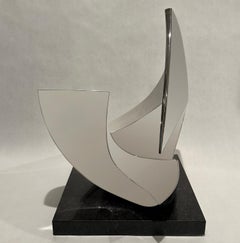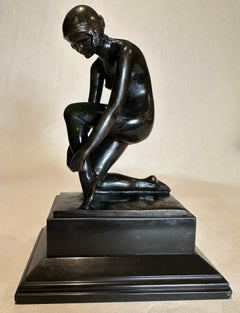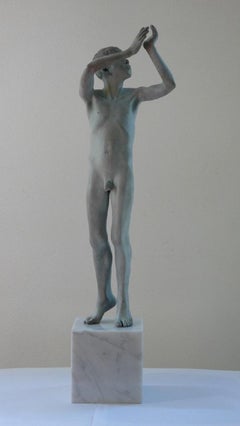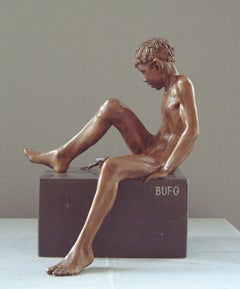Furnishings and Fittings Sculptures
to
1
2
1
Overall Width
to
Overall Height
to
1
3
1
1
2
2
2
1
1
1
1
1
4
3
2
1
1
1
1
4
Native American On Horseback Bronze Sculpture Daro Flood
By Daro Flood
Located in Norwood, NJ
Native American on horseback. Signed and numbered 24/30, artists cypher.
Daro Flood (1954 - 2017) was active/lived in Arizona. Daro Flood is known for Portrait bust Indian and cowboy sculpture...
Category
Late 20th Century Realist Figurative Sculptures
Materials
Bronze
Family Of Lions Bronze By Paul Édouard Delabrierre
By Paul Edouard Delabriere
Located in Norwood, NJ
A family of lions having green patination depicting a male lion feeding two cubs; mounted on a naturalistic base - signed and applied entitled plaque "Lion 1st Gibier"
Paul Edouard Delabrierre...
Category
Late 19th Century Figurative Sculptures
Materials
Bronze
Stainless Steel Sculpture "Two Forms" By Roy Gussow
Located in Norwood, NJ
Polished stainless steel abstract sculpture, "Two Forms" by Roy Gussow (American, 1918-2011), marked and dated with coin seal inlaid to marble base. Similar...
Category
Mid-20th Century Abstract Geometric Abstract Sculptures
Materials
Granite, Stainless Steel
Kneeling Female Nude, Bronze By Mario Korbel
Located in Norwood, NJ
Joseph Mario Korbel (Czech/American, 1882-1954). Period fine example bronze, dark brown patina, modeled as a nude female kneeling and tying her sandal, raised on a stepped black marb...
Category
Early 20th Century Art Deco Figurative Sculptures
Materials
Marble, Bronze
Related Items
Gallulus Bronze Sculpture Nude Boy Male Figure Green Patina Marble Stone
By Wim van der Kant
Located in Utrecht, NL
Gallulus Bronze Sculpture Nude Boy Male Figure Green Patina Marble Stone
Wim van der Kant (1949, Kampen) is a selftaught artist. Next to his busy profess...
Category
21st Century and Contemporary Contemporary Nude Sculptures
Materials
Marble, Bronze
$9,616
H 16.54 in W 7.88 in
Bufo Contemporary Bronze Sculpture Nude Boy Marble Stone Male Figure
By Wim van der Kant
Located in Utrecht, NL
Bufo Contemporary Bronze Sculpture Nude Boy Marble Stone Male Figure
Wim van der Kant (1949, Kampen) is a selftaught artist. Next to his busy profession as a teacher at a high school, he intensively practises his profession as a sculptor. Only when his work would measure up to his own standards, he decided to present it to the rest of the world. In 1995, he exhibited for the first time with Morren Galleries. Van der Kant desires to sculpt young people who still stand uninhibited and curiously in life. The reason he chooses to sculpt boys is, because he is one himself, this way the subject is closer to him. The anatomy of his figures testify of perfectionism. Van der Kant's subjects show similarities with the sculptures from the Greek and Roman antiquity...
Category
21st Century and Contemporary Contemporary Nude Sculptures
Materials
Marble, Bronze
$10,676
H 12.21 in W 7.88 in
Aquila Bronze Sculpture Nude Boy Marble Stone Contemporary In Stock
By Wim van der Kant
Located in Utrecht, NL
Aquila Bronze Sculpture Nude Boy Marble Stone Contemporary In Stock - Sculpture without Stone is 57 cm high
Wim van der Kant (1949, Kampen) is a selftaught a...
Category
21st Century and Contemporary Contemporary Nude Sculptures
Materials
Marble, Bronze
$16,897
H 27.56 in W 7.88 in D 7.88 in
"Sudbourne Premier: Suffolk Punch Stallion" Herbert Haseltine, 1927 Bronze
Located in New York, NY
Herbert Haseltine
Sudbourne Premier: Suffolk Punch Stallion, 1927
Signed left side: © HASELTINE / MCMXXVII
Bronze, dark brown patina, parcel gilding
...
Category
1920s Realist Figurative Sculptures
Materials
Bronze
$35,000
H 10.5 in W 11.5 in D 6.5 in
Aestus Bronze Sculpture Marble Stone Nude Boy Contemporary
By Wim van der Kant
Located in Utrecht, NL
Aestus Bronze Sculpture Marble Stone Nude Boy Contemporary
Wim van der Kant (1949, Kampen) is a selftaught artist. Next to his busy profession as a teacher ...
Category
21st Century and Contemporary Contemporary Nude Sculptures
Materials
Marble, Bronze
$18,091
H 20.87 in W 3.94 in
Crepis Bronze Sculpture Nude Boy Male Figure Marble Stone
By Wim van der Kant
Located in Utrecht, NL
Crepis Bronze Sculpture Nude Boy Male Figure Marble Stone
Wim van der Kant (1949, Kampen) is a selftaught artist. Next to his busy profession as a teacher at...
Category
21st Century and Contemporary Contemporary Nude Sculptures
Materials
Marble, Bronze
$16,395
H 17.72 in W 7.88 in
19th Century Bronze of the Borghese Gladiator Sculpture
Located in Beachwood, OH
The Borghese Gladiator, 19th Century
Bronze on marble base
Musée du Louvre signed on base
15 x 12 x 8 inches
Since its discovery in the early seventeenth century, the Borghese Gladi...
Category
19th Century Figurative Sculptures
Materials
Marble, Bronze
Agathon Leonard Silvered Bronze Of Marguerite
By Agathon Léonard
Located in Dallas, TX
Agathon Leonard (French, 1841 - 1923) Art Nouveau Silvered Bronze
A French Art Nouveau gilt bronze sculpture, "Marguerite", by Agathon Léonard of Margeruite, placing a flower in her...
Category
1890s Art Nouveau Figurative Sculptures
Materials
Bronze
Nude Female Torso Bronze Sculpture, 20th Century Contemporary American Artist
Located in Beachwood, OH
Alan Cottrill (American, Ohio, b. 1952)
Nude Female Torso, 1994
Bronze mounted to green marble base
Signed, dated and numbered 14/20 verso of leg, with foundry stamp
17. in. h. x 6 i...
Category
1990s Figurative Sculptures
Materials
Marble, Bronze
$2,500
H 25.5 in W 6 in D 6 in
Profundus Bronze Sculpture Nude Boy Contemporary Male Figure Marble Stone
By Wim van der Kant
Located in Utrecht, NL
Profundus Bronze Sculpture Nude Boy Contemporary Male Figure Marble Stone
Wim van der Kant (1949, Kampen) is a selftaught artist. Next to his busy p...
Category
21st Century and Contemporary Contemporary Nude Sculptures
Materials
Marble, Bronze
$16,395
H 22.05 in W 22.05 in
Figure of Crouching Venus/Naked Aphrodite, 19th Century Italian School Sculpture
Located in Beachwood, OH
Bronze Figure of Crouching Venus, or The Naked Aphrodite, 19th Century Italian School
Bronze raised on a marble base
21 in. h. x 10 in. w. x 7 in. d., overall
18 in. h. x 8.5 in. w....
Category
19th Century Figurative Sculptures
Materials
Marble, Bronze
$3,250
H 21 in W 10 in D 7 in
1920s Italian Art Decò Signed Bronze Sculpture Nude of Woman
By Gaetano Martinez
Located in Roma, IT
Wonderful Italian sculpture representing a seated maiden.
The artwork rests on a square marble base
Signed on the base “Gaetano Martinez Roma”
According a written opinion by Prof. Al...
Category
1920s Art Deco Figurative Sculptures
Materials
Marble, Bronze
$3,581
H 11.82 in W 5.52 in D 7.88 in



